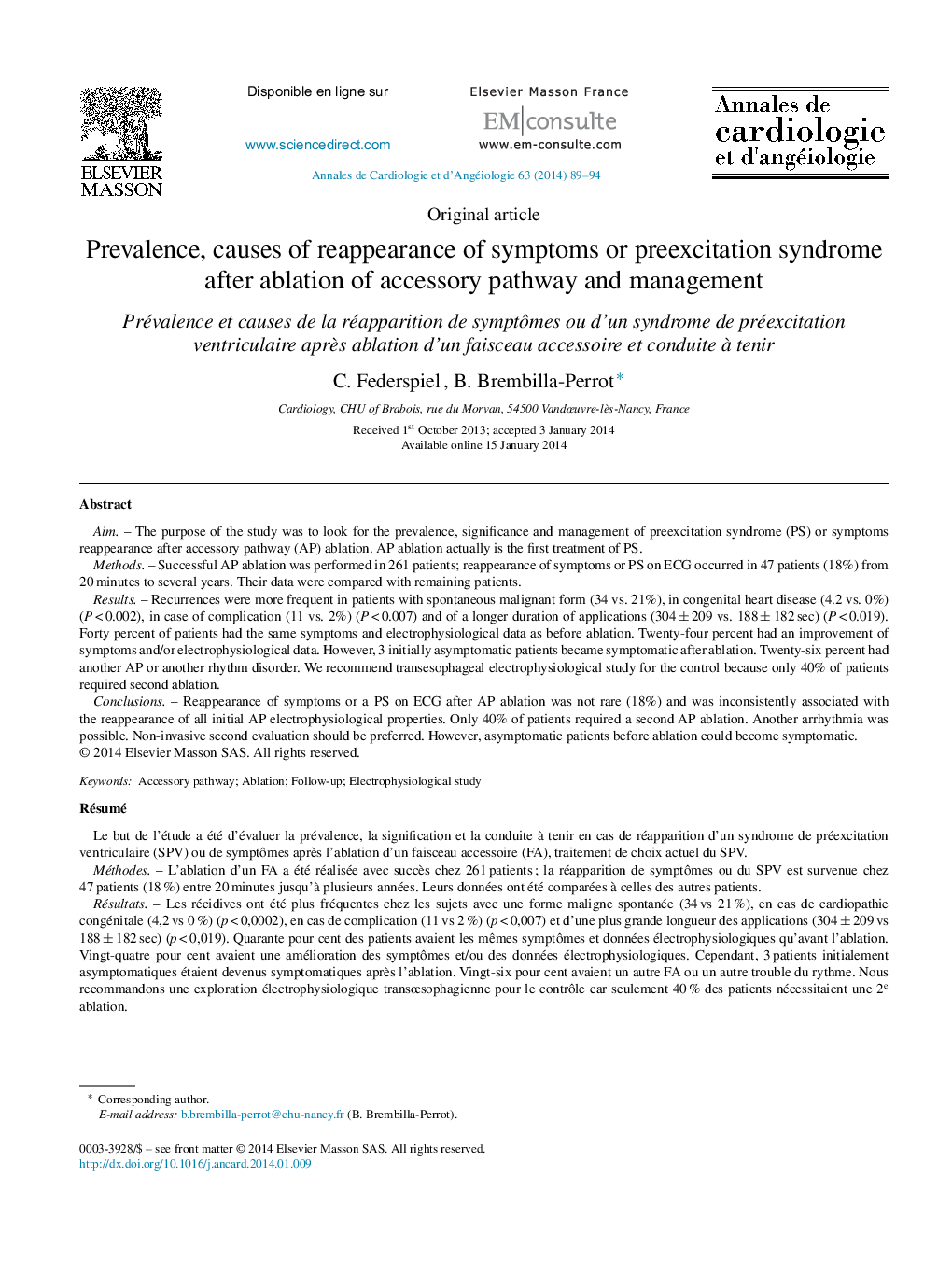| Article ID | Journal | Published Year | Pages | File Type |
|---|---|---|---|---|
| 2868797 | Annales de Cardiologie et d'Angéiologie | 2014 | 6 Pages |
AimThe purpose of the study was to look for the prevalence, significance and management of preexcitation syndrome (PS) or symptoms reappearance after accessory pathway (AP) ablation. AP ablation actually is the first treatment of PS.MethodsSuccessful AP ablation was performed in 261 patients; reappearance of symptoms or PS on ECG occurred in 47 patients (18%) from 20 minutes to several years. Their data were compared with remaining patients.ResultsRecurrences were more frequent in patients with spontaneous malignant form (34 vs. 21%), in congenital heart disease (4.2 vs. 0%) (P < 0.002), in case of complication (11 vs. 2%) (P < 0.007) and of a longer duration of applications (304 ± 209 vs. 188 ± 182 sec) (P < 0.019). Forty percent of patients had the same symptoms and electrophysiological data as before ablation. Twenty-four percent had an improvement of symptoms and/or electrophysiological data. However, 3 initially asymptomatic patients became symptomatic after ablation. Twenty-six percent had another AP or another rhythm disorder. We recommend transesophageal electrophysiological study for the control because only 40% of patients required second ablation.ConclusionsReappearance of symptoms or a PS on ECG after AP ablation was not rare (18%) and was inconsistently associated with the reappearance of all initial AP electrophysiological properties. Only 40% of patients required a second AP ablation. Another arrhythmia was possible. Non-invasive second evaluation should be preferred. However, asymptomatic patients before ablation could become symptomatic.
RésuméLe but de l’étude a été d’évaluer la prévalence, la signification et la conduite à tenir en cas de réapparition d’un syndrome de préexcitation ventriculaire (SPV) ou de symptômes après l’ablation d’un faisceau accessoire (FA), traitement de choix actuel du SPV.MéthodesL’ablation d’un FA a été réalisée avec succès chez 261 patients ; la réapparition de symptômes ou du SPV est survenue chez 47 patients (18 %) entre 20 minutes jusqu’à plusieurs années. Leurs données ont été comparées à celles des autres patients.RésultatsLes récidives ont été plus fréquentes chez les sujets avec une forme maligne spontanée (34 vs 21 %), en cas de cardiopathie congénitale (4,2 vs 0 %) (p < 0,0002), en cas de complication (11 vs 2 %) (p < 0,007) et d’une plus grande longueur des applications (304 ± 209 vs 188 ± 182 sec) (p < 0,019). Quarante pour cent des patients avaient les mêmes symptômes et données électrophysiologiques qu’avant l’ablation. Vingt-quatre pour cent avaient une amélioration des symptômes et/ou des données électrophysiologiques. Cependant, 3 patients initialement asymptomatiques étaient devenus symptomatiques après l’ablation. Vingt-six pour cent avaient un autre FA ou un autre trouble du rythme. Nous recommandons une exploration électrophysiologique transœsophagienne pour le contrôle car seulement 40 % des patients nécessitaient une 2e ablation.ConclusionsLa réapparition de symptômes ou d’un SPV après l’ablation d’un FA n’a pas été rare (18 %) mais était inconstamment associée à une réapparition des propriétés initiales du FA. Seulement 40 % des patients nécessitaient une seconde ablation. Une autre arythmie était possible. Une seconde exploration non invasive devrait être préférée. Cependant, des patients asymptomatiques avant l’ablation pouvaient devenir symptomatiques après.
